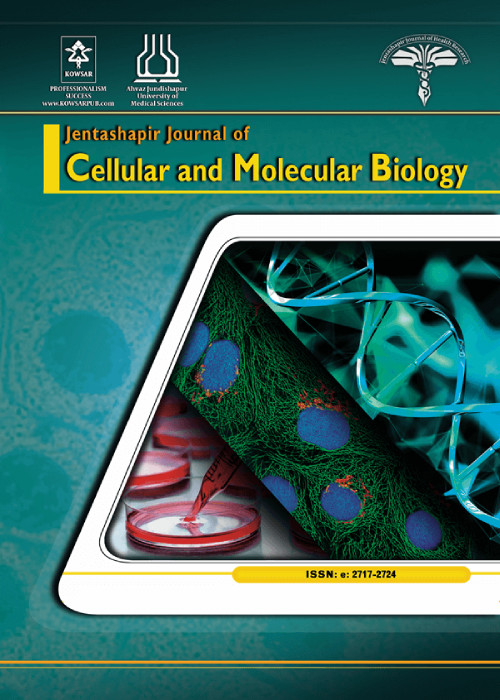فهرست مطالب

Jentashapir Journal of Cellular and Molecular Biology
Volume:13 Issue: 1, Mar 2022
- تاریخ انتشار: 1401/05/15
- تعداد عناوین: 8
-
-
Page 1Background
Polyamine metabolism has a critical role in cancer initiation and progression. The abnormal overexpression of the ornithine decarboxylase (ODC1) enzyme gene could be a characteristic of cancer cells.
ObjectivesThe current study evaluated the cytotoxic effects of Rheum khorasanicum extract in three different solvents, including distilled water, ethanol, and n-hexane, on the MCF-7 breast cancer cell line and assessed the expression level of the ODC1 gene upon the abovementioned treatments.
MethodsWe cultured MCF-7 cancer cells in complete cell culture media and subsequently subjected them to increasing concentrations (0 - 200 µg/mL) of the extract. The cytotoxic activity of the extract was investigated using an MTT assay. The quantitative analysis of ODC1 gene expression was performed using real-time PCR.
ResultsThe cell viability was significantly decreased in concentration- and time-dependent manners. The mRNA expression of the ODC1 gene declined gradually with the increasing concentrations of extracts.
ConclusionsOur findings indicated that R. khorasanicum extract could potentially influence ODC1 gene expression in breast cancer cells and exert inhibitory effects on cancer cell proliferation.
BackgroundPolyamine metabolism has a critical role in cancer initiation and progression. The abnormal overexpression of the ornithine decarboxylase (ODC1) enzyme gene could be a characteristic of cancer cells.
ObjectivesThe current study evaluated the cytotoxic effects of Rheum khorasanicum extract in three different solvents, including distilled water, ethanol, and n-hexane, on the MCF-7 breast cancer cell line and assessed the expression level of the ODC1 gene upon the abovementioned treatments.
MethodsWe cultured MCF-7 cancer cells in complete cell culture media and subsequently subjected them to increasing concentrations (0 - 200 µg/mL) of the extract. The cytotoxic activity of the extract was investigated using an MTT assay. The quantitative analysis of ODC1 gene expression was performed using real-time PCR.
ResultsThe cell viability was significantly decreased in concentration- and time-dependent manners. The mRNA expression of the ODC1 gene declined gradually with the increasing concentrations of extracts.
ConclusionsOur findings indicated that R. khorasanicum extract could potentially influence ODC1 gene expression in breast cancer cells and exert inhibitory effects on cancer cell proliferation.
Keywords: ODC1, Rheum khorasanicum, MCF-7, Breast Cancer, Cytotoxicity -
Page 2Background
Type 2 diabetes (T2D) is associated with hyperglycemia as a metabolic disorder. Several inflammatory cytokines, including IL-6, have been implicated in developing depression in people with type 2 diabetes.
ObjectivesThe present study aimed to analyze the expression of the IL-6 gene in individuals with concurrent diabetes and depression.
MethodsA total of 50 cases with concurrent T2D and depression, as a case group and 50 patients with T2D only, as a control group, were referred to the Endocrinology and Metabolism Research Institute, Tehran University of Medical Sciences. The total RNA was extracted from the blood samples of all subjects. Real-time PCR was used to evaluate the expression of the IL-6 gene quantitatively.
ResultsThere was a decrease in the expression of IL-6 in T2D patients suffering from depression (0.62±0.39) compared with those suffering from T2D alone (0.65 ± 0.43). This reduction was, however, not statistically significant (P > 0.05).
ConclusionsAccording to the findings, IL-6 gene expression is not linked to post-diabetes depression. Further studies are warranted to unravel the precise mechanism of IL-6 in the development of depression in cases diagnosed with T2D.
Keywords: Gene Expression, Type 2 Diabetes, IL-6, Depression, Post-diabetes Depression -
Page 3Background
Stress can alter behavioral parameters, oxidative stress markers, and electrocardiographic (ECG) records. Also, metal oxide nanoparticles can affect behavioral and oxidative stress parameters in animal models, but their effects on the physiological functions of the body in stress situations and ECG changes are not yet clear.
ObjectivesIn this study, motor activity, ECG records, and oxidant/antioxidant balance changes were investigated following administration of nanoparticles of magnesium oxide (nano-MgO) and zinc oxide (nano-ZnO) in normal and acute restraint stressed rats.
MethodsAdult male Wistar rats were divided into 16 groups, including control (saline), restraint stress (90, 180, and 360 minutes + saline), nano-MgO, and nano-ZnO (1, 5, and 10mg/kg, intraperitoneally) groups, with or without restraint stress of 90minutes. Motor activities were evaluated by the elevated plus maze (EPM) and open field tests. Electrocardiographic parameters were evaluated in the 6 groups. Catalase (CAT) activity and malondialdehyde (MDA) level were measured in the cerebellum + brain stem and brain hemispheres of animals.
ResultsMotor activity was decreased by the stress of 90 minutes, nano-MgO 10 mg/kg, and nano-ZnO 10 mg/kg. The PR interval and ST height were decreased by the stress of 90 minutes. The QRS interval was increased by nano-MgO 5 mg/kg, and QRS amplitude, T amplitude, and ST height were decreased by nano-MgO 5mg/kg. The QT interval and QTc were increased by nano-ZnO 5mg/kg, and ST height was decreased by nano-ZnO 5 mg/kg. The PR interval, QRS interval, QTc, and QT interval were increased by nano-MgO 5 mg/kg in the stress of 90 minutes, and the heart rate (HR) and ST height were decreased by nano-MgO 5 mg/kg in the stress of 90 minutes. HR, QRS interval, and QTc were increased by nano-ZnO 5 mg/kg in the stress of 90 minutes, and T amplitude and ST height were decreased by nano-ZnO 5 mg/kg in the stress of 90 minutes. The MDA level was increased by nano-MgO and nano-ZnO in the brain hemisphere and cerebellum + brain stem, and CAT activity was decreased by nano-MgO and nano-ZnO in the brain hemisphere and cerebellum + brain stem. The MDA level was increased by the restraint stress of 360 minutes in the cerebellum + brain stem while it was not changed in the brain hemispheres.
ConclusionsIt seems that the side effects of these nanoparticles on motor activity could be related to the imbalance of oxidant/antioxidant systems in the cerebellum + brain stem. Also, it is possible that nanoparticles increase the effects of acute stress on changes in ECG parameters.
Keywords: Antioxidant, Electrocardiogram, Motor activity, Nanoparticles, Rat -
Page 4Background
Colon cancer is one of the most diagnosed cancers in the modern world. Chemotherapy is one of the most relevant treatments for colon cancer, but this method of treatment has severe and sometimes irreversible side effects. Therefore, alternative treatments with fewer side effects are highly considered. Natural and herbal medicine has been proven to be a great source for these alternative treatment methods.
ObjectivesThis study aimed to investigate the anti-proliferative and cytotoxic effects of Ocimum basillicum (OB) leaf aqueous extract on human colon cancer cell lines LS174T and COLO205 and the expression of apoptotic genes.
MethodsMethyl thiazol tetrazolium (MTT) assay was performed to assess the cytotoxic effects of our extract on the aforementioned cell lines. The changes in the expression of BAX and BAD were analyzed by qPCR following the treatment of cells with our extract.
ResultsThe results of the MTT assay indicated that the extract had a cytotoxic effect and could reduce the population of live cancer cells, especially LS174T cells. The expression of BAX and BAD genes showed a significant increase in qPCR analysis in both cell lines, especially in the LS174T cells.
ConclusionsOur results showed that the extract had cytotoxic, anti-proliferative, and pro-apoptotic characteristics on previously mentioned cell lines, especially on the LS 174T cells.
Keywords: Ocimum basillicum, Colon Cancer, Chemotherapy, Apoptotic Genes -
Page 5
Chemoresistance is a severe drawback to the successful and effective treatment of colorectal cancer (CRC). Comprehensive molecular mechanisms of chemoresistance facilitate the development of effective therapeutic strategies to overcome chemoresistance in CRC. The dysregulation of several non-coding RNAs was related to chemoresistance in CRC. Considering the importance of lncRNAs and miRNAs as prognostic and response to treatment biomarkers, this review focuses on the role of miRNAs and lncRNAs in CRC chemoresistance. Non-coding RNAs have an essential role in tumor progression, metastasis, and CRC chemoresistance. Thus, miRNAs and lncRNAs can be used to respond to therapeutic biomarkers in CRC.
Keywords: Colorectal Neoplasm, Chemoresistance, lncRNA, miRNA -
Page 6Background
Irritable bowel syndrome (IBS) is a functional gastrointestinal disorder. The precise etiology of this disease is not clear, but some reports have indicated the role of infectious agents in the incidence of the disease.
ObjectivesBecause of the potential role of viruses in the incidence of the disease, this study aimed to evaluate and compare the frequency of colonic adenovirus infection in both IBS and control subjects.
MethodsStool and serum samples were collected from 40 IBS patients and 40 healthy individuals. Immunochemical detection of adenovirus (anti-adenoviral IgG and IgM monoclonal antibodies) was performed using enzyme-linked immunosorbent assay (ELISA) kits. Using a quantitative real-time polymerase chain reaction (PCR), adenovirus viral load was evaluated in the stool samples. Data were analyzed using SPSS software.
ResultsDifferences among the mean concentrations of anti-adenovirus IgM and anti-adenovirus IgG in IBS patients and healthy controls were not statistically significant (P = 0.764 and P = 0.910, respectively). Adenovirus DNA was detected in 37 patients (92.5%) and 35 healthy controls (87.5 %) with varying viral loads ranging from 0.150 to 0.225 (according to the standard curve). Viral loads showed no significant difference between the 2 groups (P = 0.958). Our findings showed no significant relationship between the presence of adenovirus infection and IBS.
ConclusionsAdenovirus DNA is almost always detectable in stool samples of IBS and control subjects. Adenoviruses are unlikely to play a significant role in the incidence of IBS. However, further studies are necessary to confirm our results or clarify the role of other gastrointestinal viruses in IBS.
Keywords: Bowel Syndrome, Gastrointestinal Disease, Infection, Adenovirus -
Page 7Background
Colorectal cancer (CRC) is one of the most common gastrointestinal cancers worldwide. It is the second leading cause of death in women after breast cancer.
ObjectivesThe present study aimed to determine the cytotoxic effects of zinc oxide (ZnO) nanoparticles on colon cancer (SW480) viability and nitric oxide (NO) level in vitro.
MethodsIn this experimental study, the values of 15.62, 31.25, 62.5, 125, 250, and 500 µg/mL of ZnO nanoparticles were considered to treat SW480 cells for 24 hours. The MTT method was used to determine cell viability. The amount of NO was also measured using the grease method. An analysis of variance (ANOVA) was used to analyze the data.
ResultsTreatment of SW480 cells with ZnO nanoparticles resulted in decreased viability in a dose-dependent pattern. NO concentration significantly increased in response to an effective dose of ZnO nanoparticles (108 µg/mL) compared to the control group (P < 0.001).
ConclusionsZnO nanoparticles have cytotoxic effects on colon cancer cells. The cytotoxic effect of ZnO nanoparticles on colon cancer cells is partly mediated by NO in cancer cells.
Keywords: SW480 cell line, ZnO Nanoparticles, Viability, NO -
Page 8Background
Natural products such as Allium jesdianum (AJ) have pharmacological properties with negligible side effects. However, their therapeutic potential has been limited by their low bioavailability. Nanocarriers improve the bioavailability and stability of flavonoids as the most common polyphenolic antioxidant.
ObjectivesThis study aimed to assess the toxic effects of Allium jesdianum extract (AJE) loaded in microemulsion (AJE-ME) on the HT-29 cells, a human colon cancer cell line.
MethodsHT-29 cells were exposed to 50µM/mL of AJE or AJE-ME for 24 h. Colony formation, cell viability percentage, flow cytometry, and gene expression studies were carried out to assess the impacts of the AJE-ME.
ResultsThe AJE-ME with the required characteristics and a slow-release AJE were prepared. AJE-ME significantly diminished the survival percentage and colony formation of HT-29 cells compared to the free AJE. Upregulation of mTOR and downregulation of Beclin1 and Atg5 indicated suppression of autophagy by the AJE-ME. Flow cytometry results showed that AJE-ME significantly increased the percentage of necrosis in the HT-29 cells. AJE-ME upregulated the expression of necroptosis-related genes such as receptorinteracting protein kinase 3(RIP1) and mixed lineage kinase domain-like pseudokinase (MLKL).
ConclusionsThese data collectively demonstrated that ME enhanced the toxic effect of AJE against human colon cancer cells by suppressing autophagy and activating necroptosis.
Keywords: Apoptosis, Necroptosis, Autophagy, Microemulsion, Colon Cancer, Allium Jesdianum


